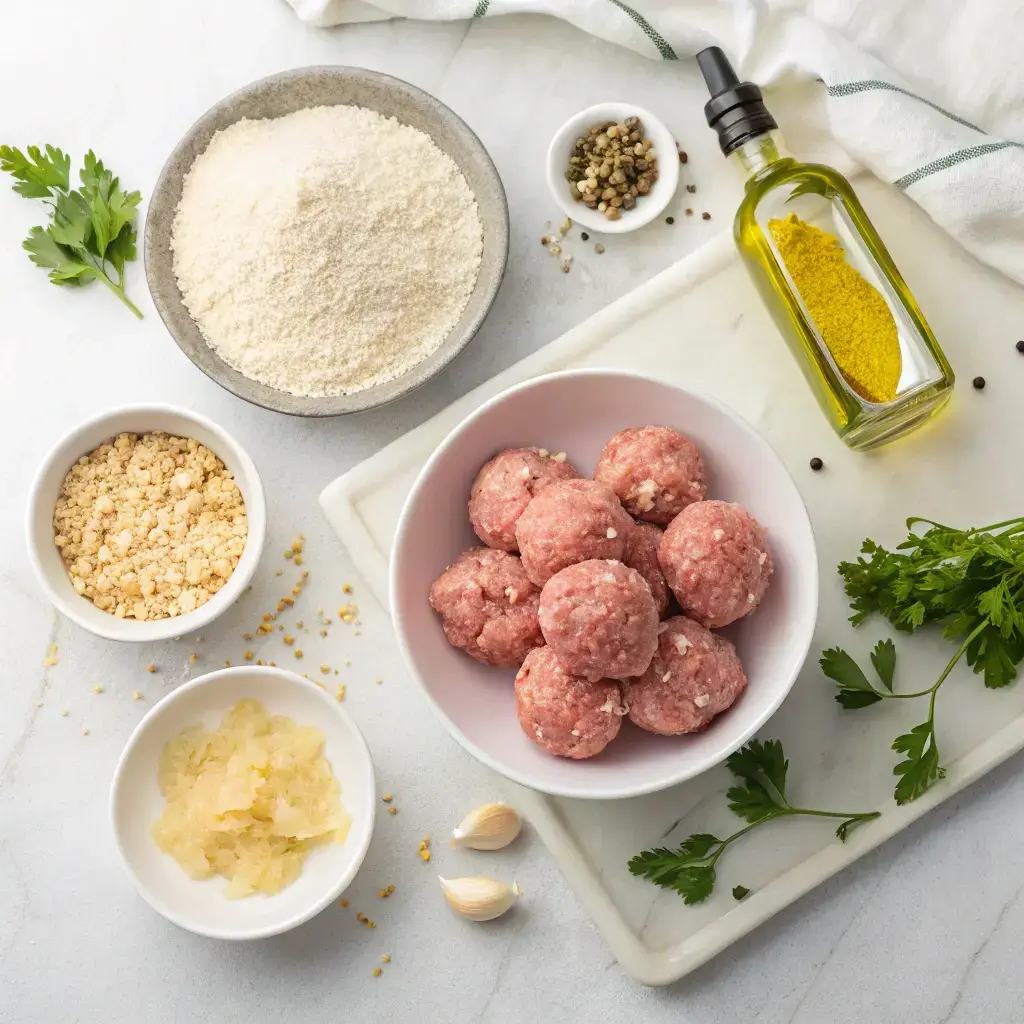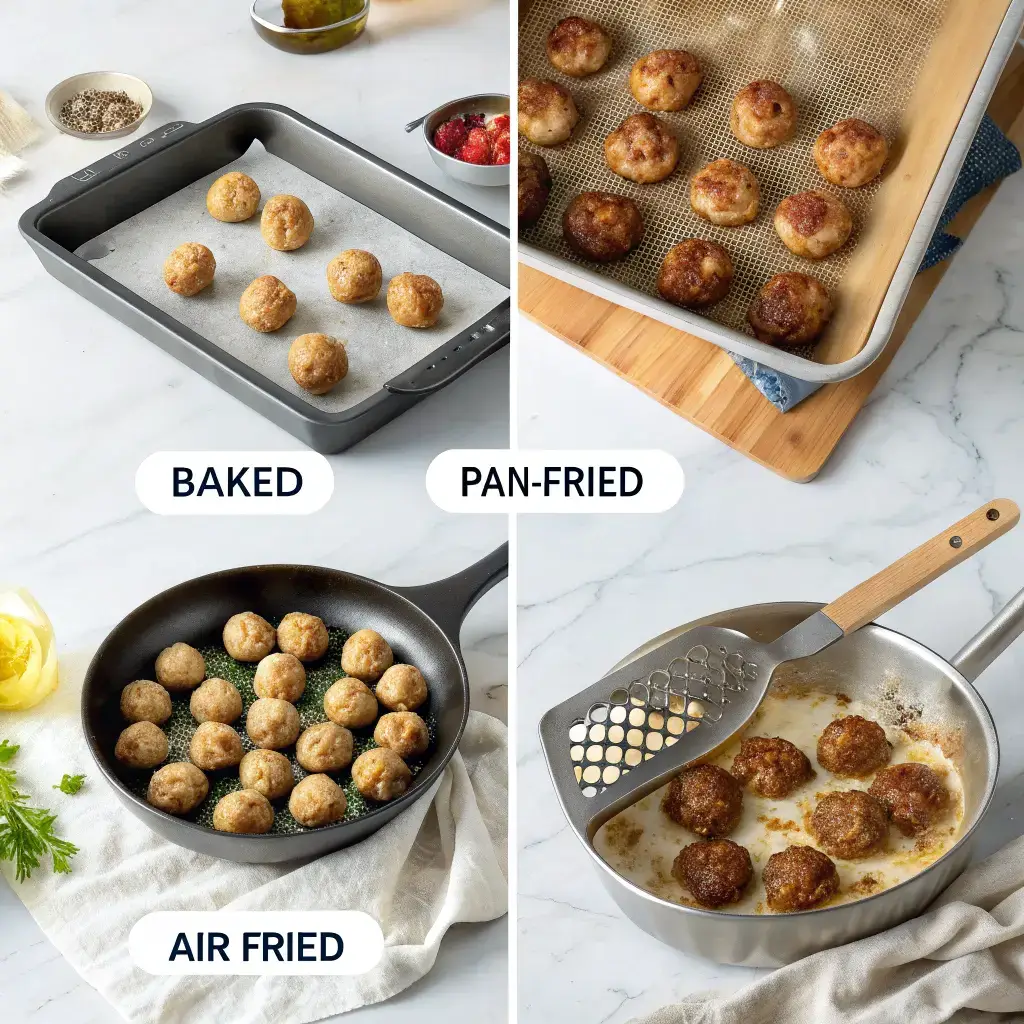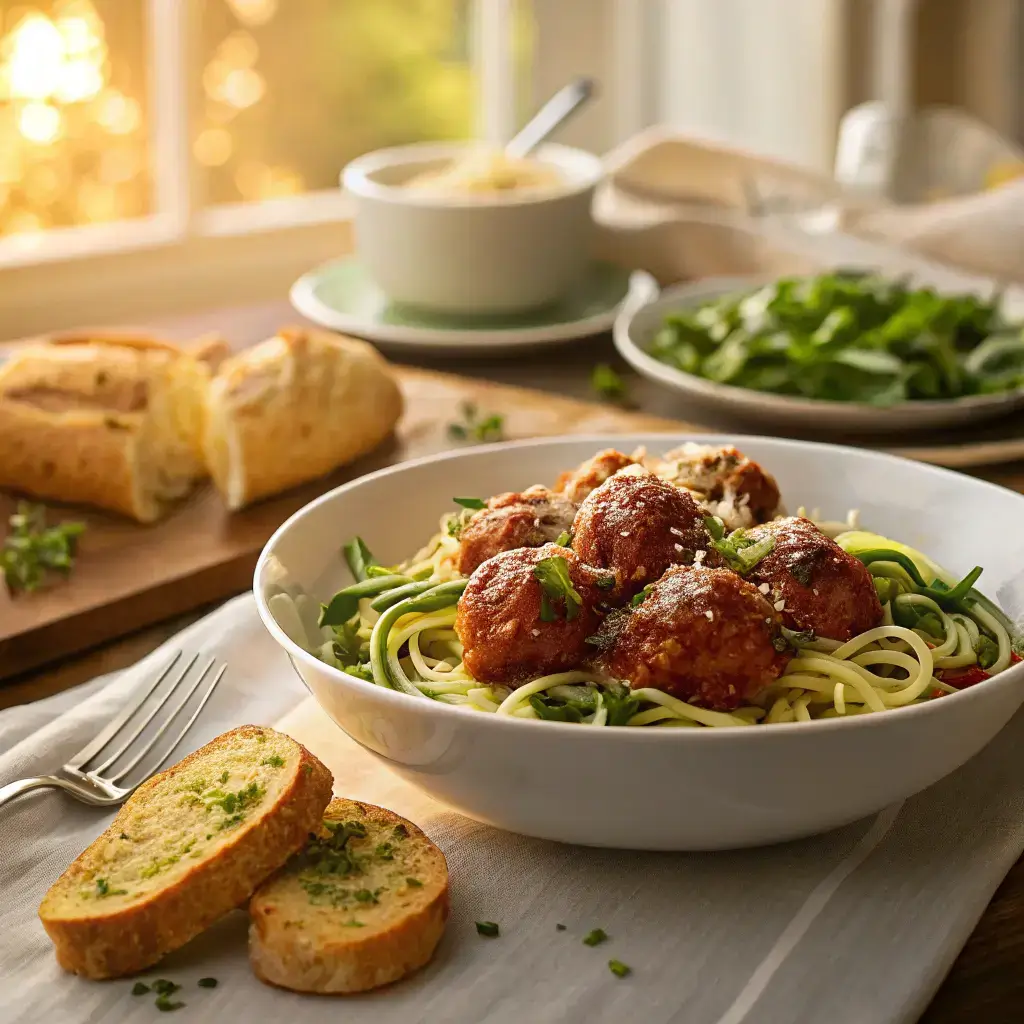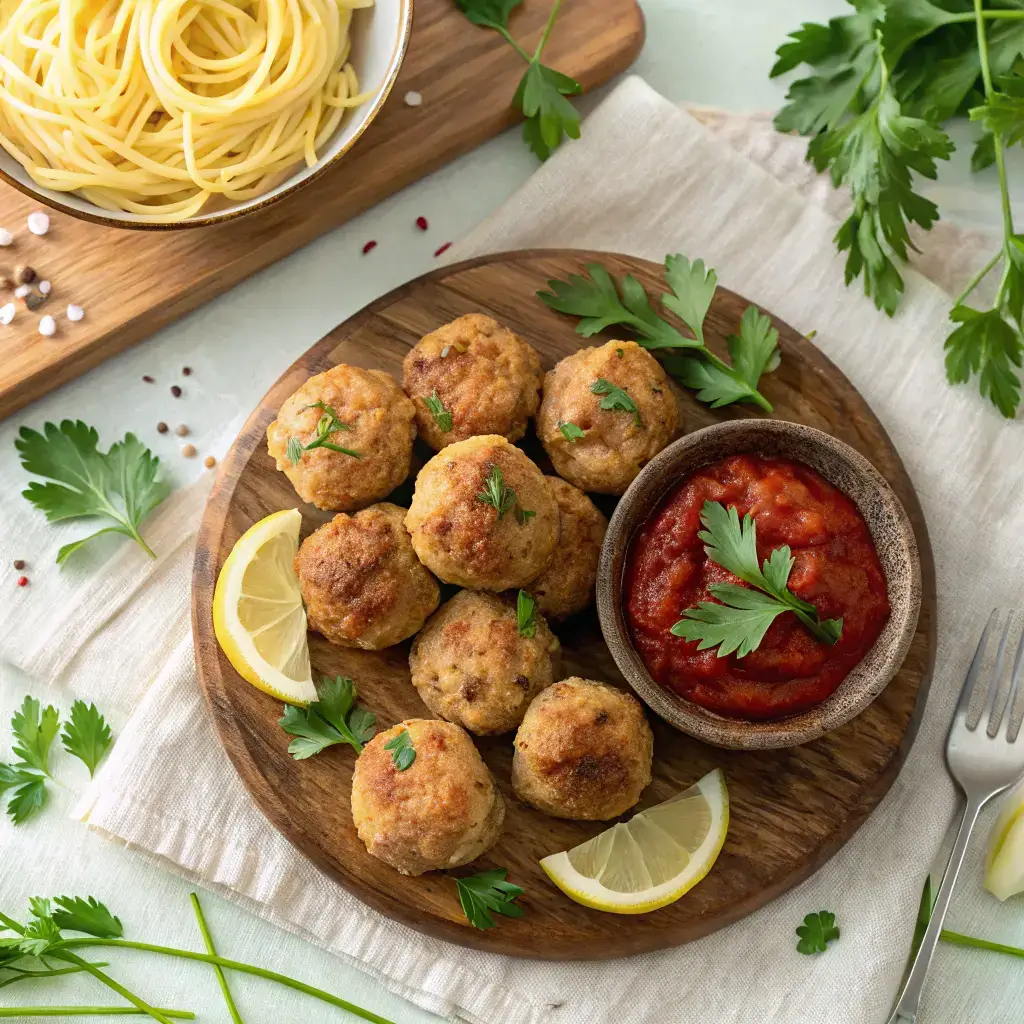Looking for a hearty, healthy, and family-approved meal that doesn’t compromise on flavor? This gluten-free turkey meatball recipe is the perfect choice for anyone following a gluten-free lifestyle or seeking a lighter alternative to traditional meatballs. Packed with lean protein and flavorful herbs, these turkey meatballs are moist, tender, and incredibly satisfying; all without any gluten-containing ingredients.
Whether you’re cooking for a weekday dinner, meal prepping for the week, or hosting a party, this dish will quickly become a staple in your kitchen. This recipe’s versatility makes it even better; it’s easy to customize with gluten-free substitutes and allergy-friendly options that fit your dietary needs.
Introduction to Gluten-Free Turkey Meatballs
What Makes This Gluten-Free Turkey Meatball Recipe Special
The secret to this gluten-free turkey meatball recipe is simplicity with a focus on nutrition and taste. Unlike many traditional meatballs that use wheat-based breadcrumbs and full-fat meats, this version uses clean, allergen-conscious ingredients. Lean ground turkey offers a light yet protein-rich base, while gluten-free binding agents and seasonings enhance the flavor without any artificial additives.
These turkey meatballs are also naturally low-carb, dairy-free, and can be easily adapted for paleo or egg-free diets. The result? A meal that works for almost everyone at your table, whether you’re gluten-sensitive or just eating cleaner.
This recipe doesn’t just follow the gluten-free trend; it redefines it. Instead of compromising on taste or texture, it elevates it with fresh herbs, gentle spices, and a preparation method that locks in flavor.
Why You Should Choose Gluten-Free and Lean Turkey Protein
Gluten-free eating isn’t just a dietary restriction; it’s a wellness movement. Choosing gluten-free meals can help reduce inflammation, improve digestion, and boost overall energy. By pairing gluten-free ingredients with lean ground turkey, you get a double dose of health benefits.
Turkey is a rich source of high-quality protein, iron, zinc, and vitamin B6—all essential for muscle development and immune support. Compared to red meats, turkey is lower in saturated fat, making it a heart-healthy option that still satisfies.
In this recipe, you’ll see how these two powerful nutritional components come together in one wholesome dish, ideal for weeknight meals or healthy meal prep.
Essential Ingredients for Gluten-Free Turkey Meatballs
High-Quality Ground Turkey: Choosing the Right Cut
When it comes to making the best gluten-free turkey meatball recipe, the choice of turkey meat plays a big role in taste and texture. Lean ground turkey, particularly a mix of white and dark meat (typically 93% lean, 7% fat), provides the perfect balance between tenderness and juiciness.

While extra-lean turkey (99% lean) might seem healthier, it often results in dry meatballs. Opting for a slightly fattier blend keeps your meatballs moist without needing excess oil or fillers. If you’re sourcing fresh turkey, ensure it’s labeled gluten-free—some pre-ground turkey may have hidden fillers or flavor enhancers that contain gluten.
Gluten-Free Binders: Alternatives to Breadcrumbs and Eggs
Traditional meatballs rely on breadcrumbs and eggs to hold their shape. But in this gluten-free turkey meatball recipe, you can easily swap in safer, allergy-friendly alternatives without compromising texture or flavor.
Here are some excellent gluten-free breadcrumb alternatives to consider:
| Gluten-Free Binder | Notes |
|---|---|
| Crushed gluten-free crackers | Crunchy, flavorful, and easy to blend into meat |
| Rolled gluten-free oats | Great binding texture, mild in flavor |
| Almond flour | Low carb, grain-free, adds a nutty aroma |
| Cooked quinoa | Protein-rich, holds moisture well |
| Mashed sweet potatoes | Naturally binding and mildly sweet |
| Chia/flaxseed “egg” | Perfect for egg-free and gluten-free combinations |
For those avoiding eggs as well, try this flax egg substitute:
1 tbsp ground flaxseed + 2.5 tbsp water = 1 egg substitute.
Let it sit for 5 minutes until it becomes gel-like before mixing it into your meatball mixture.
These swaps not only keep your recipe gluten-free but also boost its nutritional value with added fiber, protein, and healthy fats.
Step-by-Step Gluten-Free Turkey Meatball Recipe Instructions
Prepping Your Ingredients the Right Way
Before diving into the cooking process, it’s important to properly prepare your ingredients for optimal flavor and texture. Start by gathering everything you need. Here’s a list for a standard batch of 20 meatballs:
| Ingredients | Quantity |
|---|---|
| Ground turkey (93% lean) | 1 lb |
| Gluten-free binder (e.g., oats or almond flour) | ½ cup |
| Grated onion | ¼ cup |
| Garlic (minced) | 2 cloves |
| Chopped parsley | 2 tbsp |
| Salt | 1 tsp |
| Black pepper | ½ tsp |
| Italian seasoning | 1 tsp |
| Flaxseed egg (or real egg) | 1 large egg or 1 flax egg |
| Olive oil (for baking/frying) | As needed |
Make sure the binder and all seasoning ingredients are certified gluten-free to avoid any cross-contamination risks. Mixing ingredients evenly is key. Start by blending dry ingredients, then fold in the turkey and wet components gently to avoid overworking the meat—this helps keep the meatballs tender, not tough.
Cooking Method: Baking vs Pan Frying vs Air Frying
There’s no one-size-fits-all method for cooking gluten-free turkey meatballs. Here’s a quick breakdown of each approach so your readers can choose what suits them best.

Baking Method (Recommended for Meal Prep)
- Preheat oven to 400°F.
- Line a baking sheet with parchment paper.
- Roll the turkey mixture into 1.5-inch balls and place them on the tray.
- Lightly brush with olive oil.
- Bake for 18–22 minutes, flipping halfway for even browning.
This method is cleaner, healthier, and perfect for making larger batches.
Pan Frying (Crispier Texture)
- Heat 1–2 tablespoons olive oil in a non-stick skillet over medium heat.
- Cook meatballs in batches, turning every few minutes.
- Total cook time: 10–12 minutes or until fully cooked through.
Best for a crisp outer texture and a more traditional taste.
Air Frying (Fast and Low-Oil Option)
- Preheat the air fryer to 375°F.
- Lightly grease the basket with oil spray.
- Cook meatballs in a single layer for 10–12 minutes, shaking halfway.
Quick, healthy, and perfect for smaller servings.
Each of these methods offers a different texture, but all preserve the flavor-packed goodness of this gluten-free turkey meatball recipe. Choose the one that fits your lifestyle and time constraints.
Tips for Perfect Gluten-Free Turkey Meatballs Every Time
How to Keep Turkey Meatballs from Falling Apart
One of the most common issues with any gluten-free turkey meatball recipe is keeping them from falling apart. Turkey is naturally leaner and contains less fat compared to beef or pork, which means it doesn’t hold together as well without the right binders and prep techniques.
Here are some quick fixes to make sure your gluten-free turkey meatball recipe stays intact from prep to plate:
- Use the Right Binder: Gluten-free breadcrumbs, oats, almond flour, or even mashed potatoes act as glue. Be generous, but don’t overdo it.
- Add Moisture Wisely: Moist ingredients like grated onions or a splash of milk (dairy-free if needed) to help bind the mixture without making it soggy.
- Don’t Overmix: Gently fold ingredients together—overmixing makes the meatballs tough and crumbly.
- Chill Before Cooking: Letting your shaped meatballs rest in the fridge for 15–20 minutes helps them firm up before baking or frying.
- Cook Evenly: Use the same size for all meatballs to avoid undercooked or overcooked pieces that can fall apart during handling.
Texture Tricks: Moisture, Binding, and Cooking Time
Perfecting the texture of your gluten-free turkey meatball recipe comes down to three things: the right moisture, ideal binding agents, and precise cooking time.
Here’s a closer look at what works best:
| Texture Factor | What to Use / Do |
|---|---|
| Moisture | Grated onion, small splash of almond milk, or zucchini |
| Binding | Almond flour, flax egg, cooked quinoa, oats |
| Cooking Time | 18–22 mins (oven), 10–12 mins (pan/air fryer) |
| Size Matters | 1.5-inch balls cook evenly and stay moist |
| Don’t Overcook | Dry meatballs = tough texture and breakage |
Also, keep in mind that ground turkey is lean, so it cooks faster than beef. Watch your timer and don’t walk away—even a few extra minutes in the oven can change texture dramatically.
Looking for another gluten-free meal? Check out our recipe for gluten-free fluffy waffles, perfect for a healthy breakfast.
Nutritional Benefits of Gluten-Free Turkey Meatballs
Lean Protein Benefits from Turkey
When it comes to choosing a nutritious protein source, turkey is hard to beat. In this gluten-free turkey meatball recipe, the spotlight ingredient—lean ground turkey—delivers high-quality protein that fuels your body without the heaviness of fattier meats like beef or pork.
Here’s why turkey deserves a permanent place on your plate:
- High Protein, Low Fat: A 3-ounce serving of cooked ground turkey provides around 22 grams of protein with significantly less saturated fat.
- Muscle Support: Turkey’s complete protein profile includes all essential amino acids, making it excellent for post-workout meals and muscle recovery.
- Heart Health Friendly: Compared to red meats, turkey is naturally lower in cholesterol and saturated fats, helping support cardiovascular wellness.
- Rich in B Vitamins: Especially vitamins B6 and B12, which play critical roles in energy metabolism and brain function.
- Packed with Selenium and Zinc: These minerals are essential for immune support and thyroid function.
This gluten-free turkey meatball recipe doesn’t just taste great — it contributes to your health goals in a way that’s clean and sustainable.
Gluten-Free Eating: Healthier Digestion & Anti-inflammatory Support
Even if you don’t have celiac disease or gluten sensitivity, choosing gluten-free meals like these turkey meatballs can still offer wellness perks. Many people experience reduced bloating, better digestion, and increased energy by cutting out gluten-laden foods.
Here’s how going gluten-free can benefit your health:
| Health Benefit | Impact |
|---|---|
| Better Gut Health | Easier digestion with fewer irritants |
| Reduced Inflammation | May help reduce chronic inflammation markers |
| Improved Nutrient Absorption | Healthier gut lining can absorb more vitamins |
| Stable Energy Levels | No gluten crashes or bloating fatigue |
| Allergy-Friendly Meal Prep | Ideal for family or guests with food sensitivities |
By combining the power of lean protein from turkey with gluten-free ingredients, this meatball recipe delivers a one-two punch of flavor and functional nutrition.
Gluten-Free Substitutes & Alternatives in This Recipe
Best Gluten-Free Breadcrumb Substitutes
Breadcrumbs are the traditional binder in most meatball recipes — but not in this one. To make this dish truly a gluten-free turkey meatball recipe, we swap those out with safe, flavorful, and texture-rich alternatives.
Here’s a detailed look at the top gluten-free swaps for breadcrumbs and how they impact your recipe:
| Breadcrumb Substitute | Why It Works | Flavor Profile |
|---|---|---|
| Gluten-free oats | Affordable, absorbs moisture well | Mild, slightly nutty |
| Crushed GF crackers | Great crunch and texture | Savory, buttery |
| Almond flour | Grain-free, high-protein option | Light, nutty, mildly sweet |
| Cooked quinoa | Adds protein and structure | Earthy, hearty |
| Mashed sweet potato | Soft, moisture-locking texture | Sweet, smooth |
| Gluten-free panko | Lighter texture, especially for baking methods | Crispy, neutral flavor |
These options don’t just serve as substitutes — they actually enhance the dish by introducing new flavors and nutritional value.
Egg-Free Binding Options for Allergy-Friendly Recipes
Many people with dietary restrictions also avoid eggs. Whether it’s due to allergies or a vegan lifestyle, this gluten-free turkey meatball recipe can be modified easily to be egg-free without compromising structure.
Here are smart egg alternatives that help bind meatballs perfectly:
| Egg Substitute | How to Use | Best For |
|---|---|---|
| Flax egg | 1 tbsp flaxseed meal + 2.5 tbsp water | Fiber boost, neutral flavor |
| Chia egg | 1 tbsp chia seeds + 2.5 tbsp water | Omega-3 boost, firm hold |
| Mashed avocado | ¼ cup per egg | Creamy texture, mild taste |
| Mashed banana | ¼ cup per egg | Slightly sweet profile |
| Unsweetened applesauce | ¼ cup per egg | Light, moist texture |
Let the flax or chia “egg” sit for about 5 minutes to develop a gel-like consistency before mixing into the meatball mixture. This offers a plant-based solution that keeps everything intact.
You can also combine substitutes, such as using almond flour for structure and chia seeds for binding, for a nutrient-dense combo.
Meal Pairings & Serving Ideas
Gluten-Free Pasta, Rice, or Zoodles Pairings

The beauty of this gluten-free turkey meatball recipe lies in its versatility — you can pair it with a wide range of gluten-free sides to create a balanced, crowd-pleasing meal. Whether you’re feeding picky eaters or prepping for a cozy dinner, here are some top pairing ideas:
| Side Dish | Why It Works |
|---|---|
| Gluten-free pasta | Classic combo, perfect with marinara or pesto sauce |
| Brown rice or jasmine rice | Adds hearty texture, balances protein-rich meatballs |
| Zucchini noodles (zoodles) | Low-carb option, fresh and light pairing |
| Mashed cauliflower | Creamy, keto-friendly and dairy-free alternative |
| Quinoa pilaf | Nutrient-dense, fiber-rich and slightly nutty flavor |
You can also drizzle a homemade tomato basil sauce, a creamy dairy-free Alfredo, or even a tangy BBQ glaze depending on your flavor preference.
Serving Suggestions for Parties, Kids, and Meal Prep
This gluten-free turkey meatball recipe isn’t just for dinner — it’s a go-to for every occasion. Whether you’re hosting guests, prepping school lunches, or planning a healthy weekly menu, here’s how to serve it up in style:
For Parties or Appetizers:
- Serve meatballs on toothpicks with dipping sauces (honey mustard, buffalo, or chipotle mayo).
- Mini meatballs with a side of gluten-free slider buns make fun, kid-friendly bites.
For Kids:
- Pair with gluten-free mac and cheese.
- Stuff into pita pockets with veggies and dairy-free ranch.
For Meal Prep:
- Store in pre-portioned containers with brown rice and roasted veggies.
- Freeze in meal packs with side sauces for quick microwave reheating.
These flexible ideas keep things fresh and exciting all week long — and they also make healthy eating more enjoyable and sustainable.
Storing, Freezing & Reheating Gluten Free Turkey Meatballs
How to Freeze Without Losing Texture
One of the top reasons this gluten-free turkey meatball recipe is ideal for meal prep is its ability to freeze beautifully. But freezing meatballs the right way ensures they maintain their flavor and texture — no soggy or rubbery surprises.
Here’s a quick guide to freezing them correctly:
| Step | Action |
|---|---|
| Cool completely | Let meatballs cool to room temperature after cooking |
| Flash freeze first | Place on a parchment-lined baking sheet and freeze for 1 hour individually |
| Transfer to airtight bags | After flash freezing, move meatballs to freezer-safe containers or zip-top bags |
| Label and date | Always mark the container with the freeze date |
| Freeze for up to | 3 months without loss of flavor or structure |
Pro Tip: Separate layers using parchment paper to avoid sticking if stored in containers.
Flash-freezing is key — it prevents meatballs from clumping together and helps them reheat evenly later.
Best Ways to Reheat Without Drying Out
No one wants dry or rubbery meatballs — even the best gluten-free turkey meatball recipe can lose its magic if not reheated correctly. Here’s how to reheat them while keeping the inside moist and the outside slightly crisp:
| Reheating Method | Instructions |
|---|---|
| Oven (best method) | Preheat to 350°F, place on a tray, cover loosely with foil, and reheat 10–12 minutes |
| Air fryer | 350°F for 5–6 minutes; spray lightly with oil |
| Microwave | Place in a microwave-safe dish with a splash of broth or water, cover, heat for 1–2 minutes |
| Stovetop | Preheat to 350°F, place on a tray, cover loosely with foil, and reheat for 10–12 minutes |
To avoid dryness, reheating in moist environments like simmered sauces or with a lid on works best. If air frying or baking, brush or spritz the meatballs with a bit of olive oil for an extra flavor punch.
FAQs
When making gluten-free turkey meatballs, some common questions often arise. Here, we answer the most frequently asked ones to help you get the best results in your kitchen!
What is a gluten-free substitute for breadcrumbs in meatballs?
If you’re looking for a gluten-free alternative to breadcrumbs, there are several options to choose from. You can use gluten-free breadcrumbs, which are widely available in stores. Alternatively, crushed gluten-free crackers, almond flour, or coconut flour can also work as binders. Oats (certified gluten-free) or ground flaxseed are excellent substitutes as well, adding both texture and nutritional value.
How do you keep turkey meatballs from falling apart?
Turkey meatballs can sometimes fall apart because of their lean nature. To prevent this, ensure you use a good binding agent (like gluten-free breadcrumbs or oats), and avoid overmixing the meat mixture. Adding a bit of moisture, such as grated vegetables or a splash of broth, can help keep the meatballs together without drying them out. Finally, chilling the meatballs for about 30 minutes before cooking can help them hold their shape better.
What can I use to bind meatballs without eggs?
If you’re avoiding eggs, there are plenty of egg-free options for binding meatballs. Common substitutes include unsweetened applesauce, mashed potatoes, flaxseed meal mixed with water (also known as a flax egg), or even a bit of Greek yogurt. These alternatives provide both the moisture and binding qualities needed to create cohesive meatballs.
What makes a turkey gluten-free?
Turkey itself is naturally gluten-free, as it’s a protein sourced from poultry. However, you need to ensure that no gluten-containing ingredients are added during processing or preparation. When purchasing a packaged ground turkey, check the label to ensure there are no hidden sources of gluten, such as in seasoning blends or fillers.
Does mayonnaise have gluten?
Most commercially prepared mayonnaise is naturally gluten-free, as it typically contains eggs, oil, and vinegar, all of which do not contain gluten. However, it’s always important to check the label for any hidden gluten sources or cross-contamination warnings. If you’re concerned, opt for a certified gluten-free mayonnaise brand to be safe.
What brand of frozen turkey is gluten-free?
Many frozen turkey products are gluten-free, but it’s essential to double-check the label. Brands like Butterball, Perdue, and Jennie-O offer gluten-free turkey options. Always verify that there are no gluten-based additives or fillers, especially in pre-seasoned varieties. Additionally, choosing fresh ground turkey instead of pre-seasoned or processed options can help you maintain a truly gluten-free meal.
These answers should help clear up any confusion and ensure that your gluten-free turkey meatballs are a success every time!

Gluten-Free Turkey Meatballs
Equipment
- Large mixing bowl
- Measuring cups and spoons
- Cutting board and knife
- Large skillet
- Wooden spoon or spatula
- Spoon or small scoop (for shaping meatballs)
- Tongs (for flipping meatballs)
Ingredients
- 3 tablespoons olive oil divided
- ½ cup onion finely diced
- 2 cloves garlic finely minced
- 1 pound ground turkey
- 2 tablespoons chopped fresh basil
- 2 tablespoons chopped fresh parsley
- ½ cup gluten-free breadcrumbs
- ½ cup grated Parmesan cheese
- 1 large egg
- 1 teaspoon salt
- ½ teaspoon ground black pepper
Instructions
- Heat 1 tablespoon of olive oil in a skillet over medium heat. Add the onion and sauté until softened, about 3-4 minutes. Add the garlic and cook for another 30 seconds, until fragrant. Remove from heat and let cool slightly.
- In a large mixing bowl, combine the ground turkey, basil, parsley, gluten-free breadcrumbs, Parmesan cheese, egg, salt, and black pepper. Add the cooked onion and garlic mixture.
- Mix everything together until just combined, being careful not to overmix.
- Use a spoon or scoop to form the mixture into meatballs, about 1 to 1.5 inches in diameter.
- Heat the remaining 2 tablespoons of olive oil in a large skillet over medium heat. Add the meatballs in batches, making sure not to overcrowd the pan. Cook for 6-8 minutes, turning occasionally, until golden brown on all sides and cooked through (internal temperature should reach 165°F/74°C).
- Remove from heat and serve warm with marinara sauce, pasta, or as desired.





